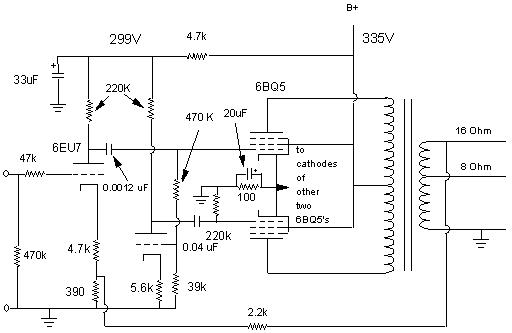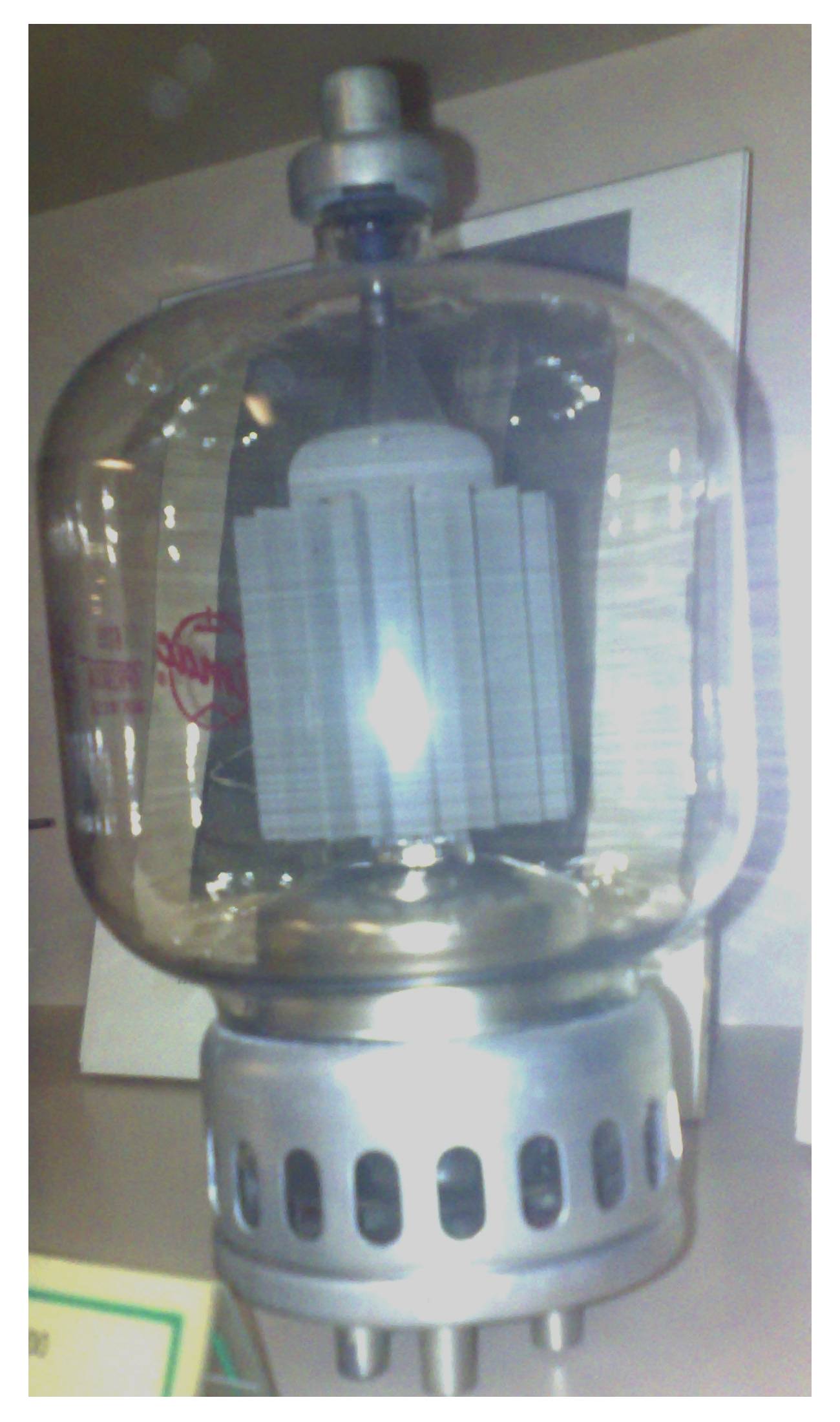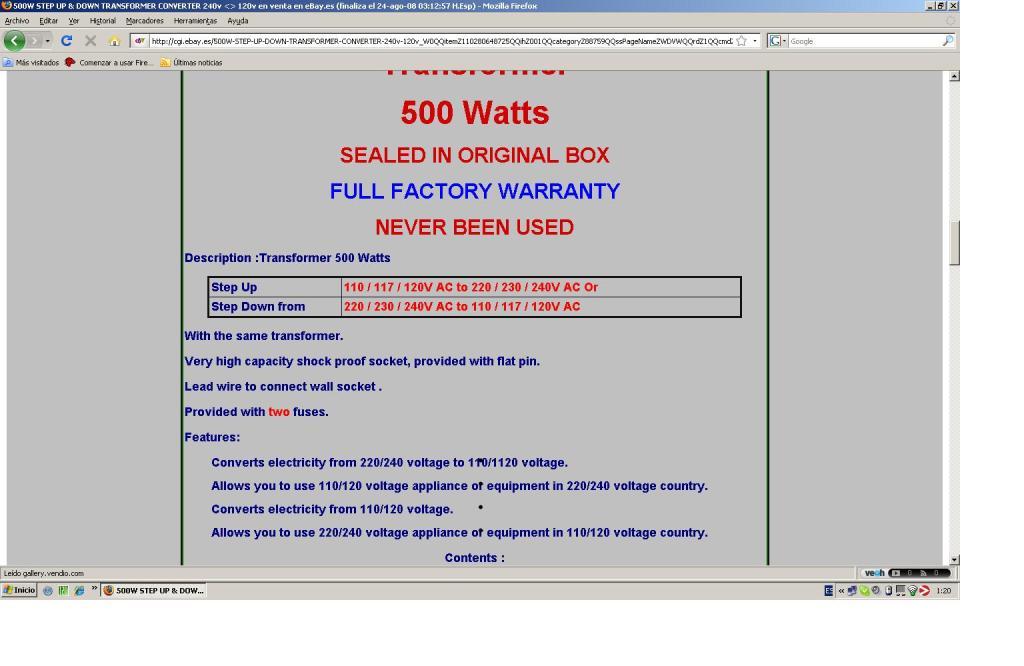Mmmh...non sono sicuro di aver capito nemmeno mi..., nel dubbio:

""...Well, let's analyze it.
The first stage is kind of straight forward. The cathode voltage is supposed to be 2 volts (not the 20 that the Sams mistakenly says). Actual measurement is about 1.5. The input has what is known as a stopper resistor, which minimizes high frequency oscillation. The gain of the stage is about 7.8. If one looks at the cathode circuit closely, one can imagine it as also being a common grid amplifier, where the input is the cathode, and the cathode resistor is a stopper, whereas the 390 ohm resistor is the input impedance. This allows both the input signal and the fed back signal to mix in the tube. This brings the tube's gain down to about 6 (2200/390 || 1/Gm+4700).
The output of that triode goes through a 0.0012 µF capacitor. This cap has a roll off at about 200 Hertz. This is OK, because it will all be brought back to a flat level with what is below it by NFB (more later). It feeds the top 6BQ5, which has a gain of about 25 (tube hooked as pentode should be a max of 500). So overall theoretical gain is 7.8 times 25 or 195. Ah, but we really need to include the output transformer in this because it steps down the voltage. So assuming that the output tubes go full swing at a B+ of 320 volts, we get the RMS voltage, or 320 X 0.707 to get 226 volts. Now, assuming that the output is the 18 watts that the EICO called for with this transformer, then we use the formula to get voltage from power and resistance (assuming 16 ohms impedance is equivalent to impedance), or V=SQRT(PR), or V=SQRT(18X16) =16.9. So, the 226 volts gets cut down to 16.9 volts. Which means that that stage amplifies the signal, assuming with bias set at 12.7 volts (measured) (12.7*.707 for RMS, or 8.98 volts) then from 8.98 to 16.9 volts is about 1.88. So open loop gain is actually about 7.8 times 1.88, or 14.66. This amp needs a 1 volt signal to put out full power open loop.
The output of this triode also goes through a voltage divider/grid resistor (for both the top pentode and the phase inverter triode) to the phase inverter triode. This stage has a gain of about 6.4 (theoretically). Not exactly even gain with the first triode, but with NFB close enough. This then amplified but inverted signal gets passed through a 0.047 microfarad capacitor that has a roll off at 18 hertz with the 220K grid resistor at the pentode.
So, the resultant signal then passes through the transformer with all of its distortions and brought back to the input to both attenuate the amplifier overall to a gain of 6. So for full power this amp needs 16.9/6 or 2.8 volts for full power out. Not a problem. I have a preamplifier that will provide this.
Now notice that all four output tubes are tied together at the cathodes going through one resistor? Usually, only one pair per channel shares a common cathode resistor for push pull operation. Although each output tube could use individual resistors, this would require a negative bias supply to bring the tubes close to cut off (class AB1 is where the tubes are close to cut off so at low volume levels they act as class A bias. At louder volume levels it behaves as a class B amp. Class B operation has tubes at cut off, but at low volume levels sound is distorted). Tying them together allows for easier self biasing schemes and the transition of a signal from one tube to the other. This usually requires matched pairs of tubes in order for both tubes to be biased at the same level (matched pair is where both tubes flow the same current at the same voltage level). I was fortunate to get a matched quad. I say this because all four have a common current source. Also with a pair of tubes in push pull, if there is a difference between the phase inverter and the output of the first tube (which we have here), the differential nature of the output tubes causes there to be a balance of output, because both signals add within the differential pair, so the output of each tube is equal.
Anyway, I was confused about how the signal didn't mix between the two channels. But I figured that is was the same reason that a long tailed pair did not have a signal at that point. Common currents cancel at that point. The bypass capacitor takes care of anything that leaks past. On the other hand, I am of the opinion that it also aids in the stereo separation. Anything that does leak past to the other channel would be out of phase with the first channel, so it might create an imaging effect. On the other hand, it does seem to make for a stiffer current control for each tube. If one is going positive, two of the others remain idle at a fixed current (This condition would be for one channel getting a pure sine wave). This is also an interesting way to make the amp more efficient. One gets the maximum gain for that one tube's full positive swing, because for that moment it only sees the resistor as its own cathode resistor. So it can provide its maximum power level while idling at a low power level.
As far as the imaging effect, I say this because of the similarity of another amplifier made by Steve Deckert at Decware. His single ended amplifier can also be bridged for 10 watts power. But when used as an SE amp, the two output tubes share a single cathode resistor also. He and others claim to have a surrounding effect from the amp. I get the same kind of imaging from this amp. ]]""
Se ho preso una cantonata, ditemelo pure
Saluti
JJT




